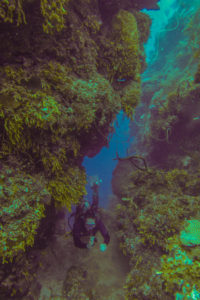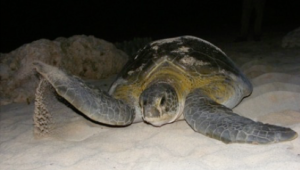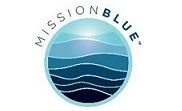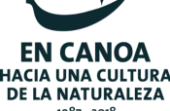Cuba’s Maria la Gorda Holds Hotspot of Biodiversity in Caribbean
Since 1970 the Caribbean region has lost some 4,000 species of fish, countless plants and nearly half of its coral reefs. Despite this alarming rate of decline, the Guanahacabibes National Marine Park located in the Pinar del Rio province in the westernmost peninsula of Cuba has remained healthy, vibrant, and intact.

Glenn Bucksbaum exploring the diverse marine habitat of Maria la Gorda. (Courtesy of Michael Garland)
Within the Guanahacabibes Peninsula is the remote area known as Maria la Gorda. The region, considered to be one of the most undisturbed and well preserved of all the Cuban reefs, holds some 150 sites of scientific interest covering a rich and diverse assortment of coral and fauna, both vertebrate and invertebrate. During a dive at Maria la Gorda, the research team, Glenn Bucksbaum and Michael Garland observed walls of color with grottos of coral reaching from the bottom of the ocean to dozens of meters high. The Guanahacabibes peninsula protects María la Gorda’s leeward fringing reefs from the prevailing northeastern trade winds and from northerly cold fronts in winter. It is believed by many scientists that further research of these healthier reefs is critical in providing future insight that could be helpful in developing coral reef conservation methods throughout the region.
Baum Foundation expedition members compared their experience from past coral restoration projects in the Grenadines with Owen Day and the CLEAR Caribbean Group to gauge the health of the Maria La Goda reefs, also noting the work of the Bellairs Institute’s Coral Research facility at Barbados. “It’s refreshing to see first hand what a healthy ecosystem can look like such as it is in Maria La Gorda, especially when you experience reefs that are very challenged like those in the Grenadines,” says Glenn Bucksbaum. In a meeting at the International Dive Center in Maria La Gorda, team members were able to discuss the joint work being done with the Florida Aquarium’s Center for Conservation and the National Aquarium of Cuba. Both groups hope to complete a major scientific endeavor by setting up an underwater nursery off the island’s westernmost point. Beginning next year, the Florida Aquarium is planning to be collecting egg and sperm bundles as the coral spawns in Maria la Gorda.
A number of other scientific initiatives have been undertaken in this region. In 1999, Maria la Gorda was the first Cuban coral reef to have been assessed by the Atlantic and Gulf Rapid Reef Assessment (AGRRA) initiative, a leading champion of coral reef conservation. By 2017, the Gulf of Mexico Marine Protected Area Network, or RedGolfo was created. This bilateral network facilitates joint efforts concerning science, stewardship, and management across five important sites, including Maria la Gorda.
The word “Guanahacabibes” comes from the Arawak Indian’s language meaning “The Place of the Iguanas.” The Guanachacabibes area benefits from the casimbos or cenotes and limestone sinkholes with natural pools and cave diving. The Guanachacabibes Peninsula has a habitat containing 126 species of birds, which is 37% of the total number of birds living in the country, as well as four species of reptiles. Four of the six orders of mammals existing in Cuba are found here. The beaches are home to the second largest breeding population of green turtles in the country, with an average of more than 300 per nest. Numerous scientific initiatives and organizations work together to support the local turtle research and conservation efforts. Dr. Maria Elena Ibarra is working with students from the University of Havana, patrolling the beaches looking as they are able to research these sea turtles from the beach as well as their ocean habitat.

A loggerhead sea turtle preparing to nest in Guanahacabibes. (Courtesy of CMRC)
One contributing factor to the pristine nature of the Maria la Gorda region, both on land and in the ocean is the relatively small human impact. There is only one human settlement at Maria la Gorda that contains less than 150 inhabitants. Should tourism and travel to the region increase, it remains to be seen what that additional human impact will affect. With Cuban tourism climbing 36% in the last two years, the research being done in this thriving area will be vitally important in finding a balance that embraces an increased human presence, but also works to maintain this special habitat.
With all the stories of buried treasure in Maria la Gorda, she is the real treasure, a place where the sediments of the sea continue their movement onward, guided only by the natural laws of life.
vvlx,
hentai,
xporn,
xnxx,
sex việt,
Family Practice Doctors Near Me,
Ratify Treaties,
Best Hookup Apps,
Brunch On A Wednesday,
Comfortzone,
Plaza Premium Lounge Orlando Reviews,
Catering 77002,
Cauliflower And Coconut Curry,
Usa Rail Pass,
Active Duty Service Member,
Patch American Flag,
Farfetch Coupon Code,
Connect Google Mini,
Nike Mens High Top,
Bronny James Usc Basketball,
Anal Sex Prep,
Aesports,
Check Balance On Debit Card,
Add People Trustpilot,
Skype Ids,
← Youth Expedition Commemorating Geographer and Explorer Antonio Núñez Jiménez
Palau Youth Work To Remove Single-Use Plastic From Their Island →




